ACC544, Decision Support Tools: Finance Assignment 3, Semester 2
VerifiedAdded on 2022/10/17
|16
|2727
|7
Homework Assignment
AI Summary
This assignment solution for ACC544, Decision Support Tools, addresses several key areas of finance and decision-making. Question 1 focuses on queuing theory and Monte Carlo simulation, involving probability calculations and simulating arrivals and appointments to analyze waiting times and idle time. Question 2 delves into cost accounting, requiring the calculation of variable costs, an explanation of learning and experience curves, and their role in cost estimation, including an 80% cost experience curve. Question 3 applies regression analysis to estimate administrative costs based on patient volume, employing the high-low method and creating a scatter diagram. It also predicts costs and uses regression models to analyze the impact of additional cost drivers. Question 4 deals with financial planning, including budgeting, break-even analysis, and the impact of changing costs and sales mix on profitability. The solution includes determining a budgeted net profit, calculating break-even points under different scenarios, and providing a memo to management with recommendations. The assignment covers a range of topics including simulation, cost accounting, regression, and financial planning, providing a comprehensive overview of decision support tools in a financial context.
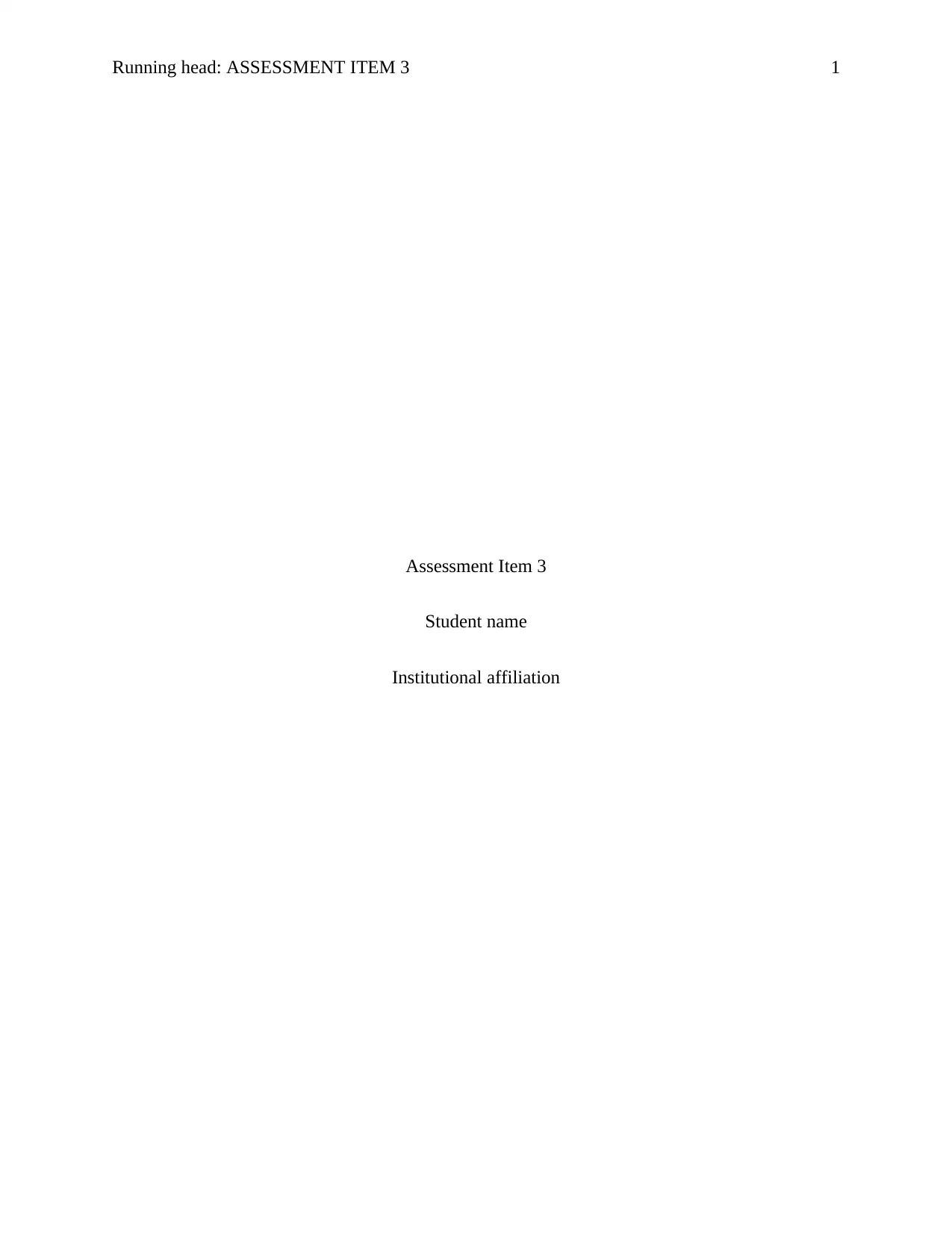
Running head: ASSESSMENT ITEM 3 1
Assessment Item 3
Student name
Institutional affiliation
Assessment Item 3
Student name
Institutional affiliation
Paraphrase This Document
Need a fresh take? Get an instant paraphrase of this document with our AI Paraphraser
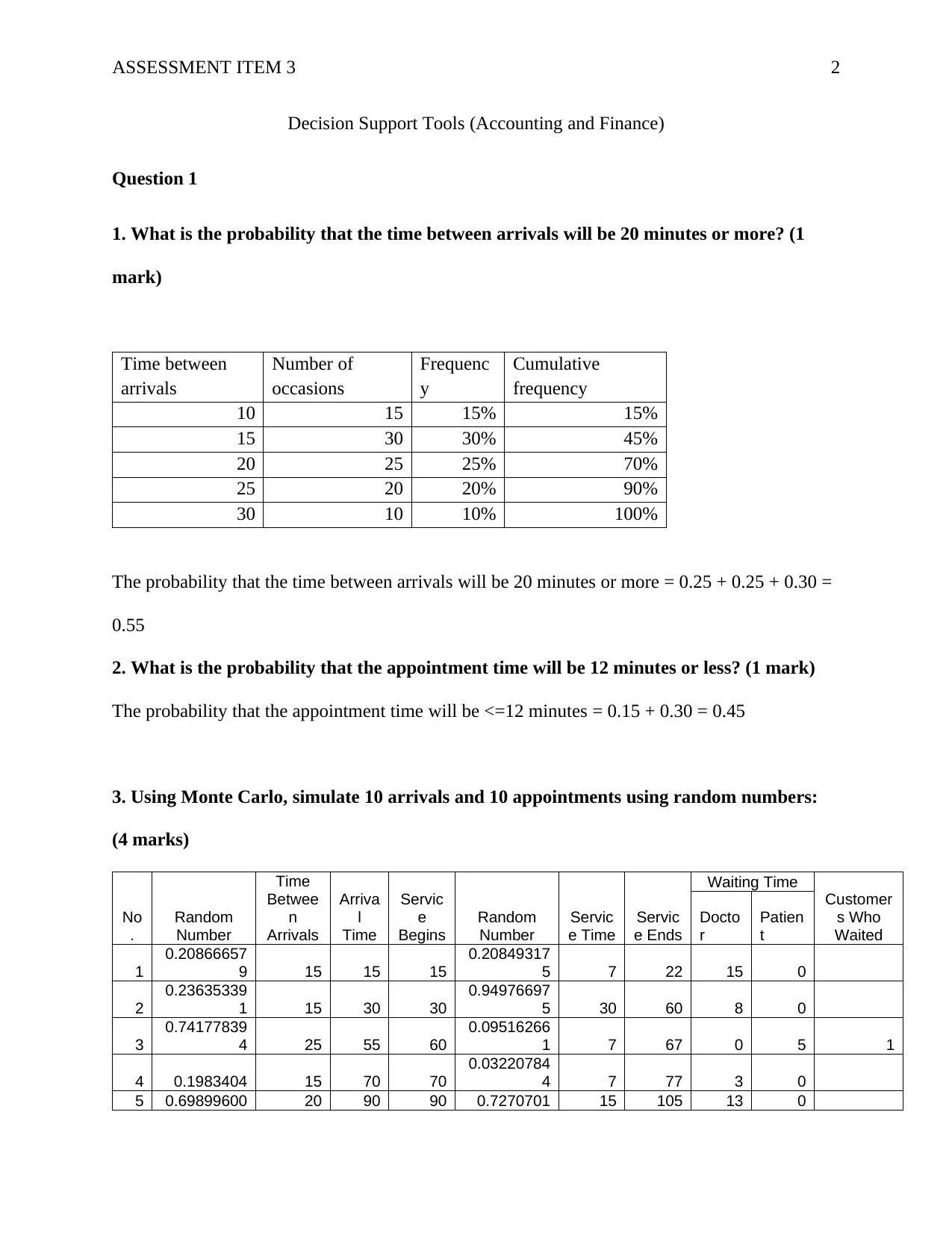
ASSESSMENT ITEM 3 2
Decision Support Tools (Accounting and Finance)
Question 1
1. What is the probability that the time between arrivals will be 20 minutes or more? (1
mark)
Time between
arrivals
Number of
occasions
Frequenc
y
Cumulative
frequency
10 15 15% 15%
15 30 30% 45%
20 25 25% 70%
25 20 20% 90%
30 10 10% 100%
The probability that the time between arrivals will be 20 minutes or more = 0.25 + 0.25 + 0.30 =
0.55
2. What is the probability that the appointment time will be 12 minutes or less? (1 mark)
The probability that the appointment time will be <=12 minutes = 0.15 + 0.30 = 0.45
3. Using Monte Carlo, simulate 10 arrivals and 10 appointments using random numbers:
(4 marks)
No
.
Random
Number
Time
Betwee
n
Arrivals
Arriva
l
Time
Servic
e
Begins
Random
Number
Servic
e Time
Servic
e Ends
Waiting Time
Customer
s Who
Waited
Docto
r
Patien
t
1
0.20866657
9 15 15 15
0.20849317
5 7 22 15 0
2
0.23635339
1 15 30 30
0.94976697
5 30 60 8 0
3
0.74177839
4 25 55 60
0.09516266
1 7 67 0 5 1
4 0.1983404 15 70 70
0.03220784
4 7 77 3 0
5 0.69899600 20 90 90 0.7270701 15 105 13 0
Decision Support Tools (Accounting and Finance)
Question 1
1. What is the probability that the time between arrivals will be 20 minutes or more? (1
mark)
Time between
arrivals
Number of
occasions
Frequenc
y
Cumulative
frequency
10 15 15% 15%
15 30 30% 45%
20 25 25% 70%
25 20 20% 90%
30 10 10% 100%
The probability that the time between arrivals will be 20 minutes or more = 0.25 + 0.25 + 0.30 =
0.55
2. What is the probability that the appointment time will be 12 minutes or less? (1 mark)
The probability that the appointment time will be <=12 minutes = 0.15 + 0.30 = 0.45
3. Using Monte Carlo, simulate 10 arrivals and 10 appointments using random numbers:
(4 marks)
No
.
Random
Number
Time
Betwee
n
Arrivals
Arriva
l
Time
Servic
e
Begins
Random
Number
Servic
e Time
Servic
e Ends
Waiting Time
Customer
s Who
Waited
Docto
r
Patien
t
1
0.20866657
9 15 15 15
0.20849317
5 7 22 15 0
2
0.23635339
1 15 30 30
0.94976697
5 30 60 8 0
3
0.74177839
4 25 55 60
0.09516266
1 7 67 0 5 1
4 0.1983404 15 70 70
0.03220784
4 7 77 3 0
5 0.69899600 20 90 90 0.7270701 15 105 13 0
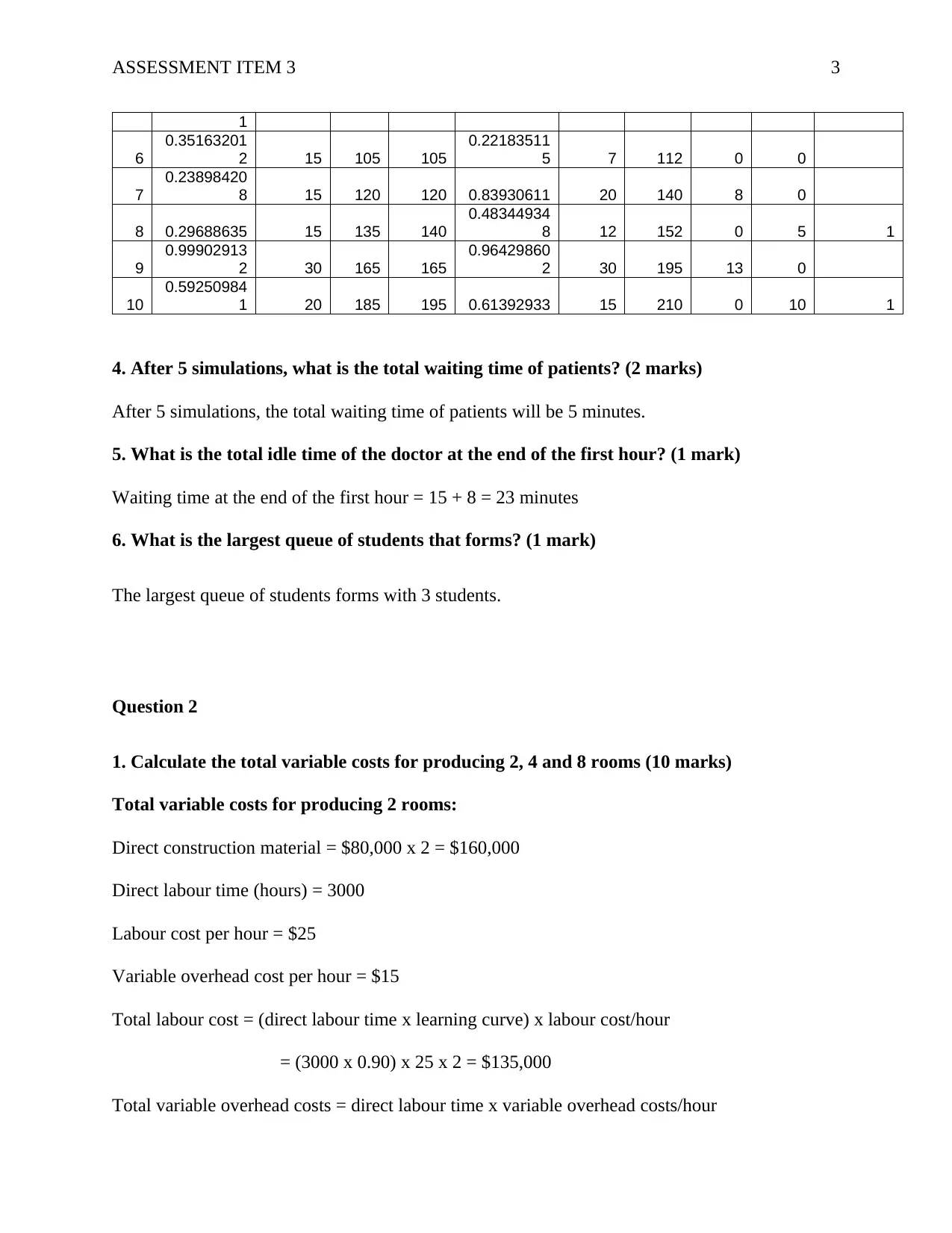
ASSESSMENT ITEM 3 3
1
6
0.35163201
2 15 105 105
0.22183511
5 7 112 0 0
7
0.23898420
8 15 120 120 0.83930611 20 140 8 0
8 0.29688635 15 135 140
0.48344934
8 12 152 0 5 1
9
0.99902913
2 30 165 165
0.96429860
2 30 195 13 0
10
0.59250984
1 20 185 195 0.61392933 15 210 0 10 1
4. After 5 simulations, what is the total waiting time of patients? (2 marks)
After 5 simulations, the total waiting time of patients will be 5 minutes.
5. What is the total idle time of the doctor at the end of the first hour? (1 mark)
Waiting time at the end of the first hour = 15 + 8 = 23 minutes
6. What is the largest queue of students that forms? (1 mark)
The largest queue of students forms with 3 students.
Question 2
1. Calculate the total variable costs for producing 2, 4 and 8 rooms (10 marks)
Total variable costs for producing 2 rooms:
Direct construction material = $80,000 x 2 = $160,000
Direct labour time (hours) = 3000
Labour cost per hour = $25
Variable overhead cost per hour = $15
Total labour cost = (direct labour time x learning curve) x labour cost/hour
= (3000 x 0.90) x 25 x 2 = $135,000
Total variable overhead costs = direct labour time x variable overhead costs/hour
1
6
0.35163201
2 15 105 105
0.22183511
5 7 112 0 0
7
0.23898420
8 15 120 120 0.83930611 20 140 8 0
8 0.29688635 15 135 140
0.48344934
8 12 152 0 5 1
9
0.99902913
2 30 165 165
0.96429860
2 30 195 13 0
10
0.59250984
1 20 185 195 0.61392933 15 210 0 10 1
4. After 5 simulations, what is the total waiting time of patients? (2 marks)
After 5 simulations, the total waiting time of patients will be 5 minutes.
5. What is the total idle time of the doctor at the end of the first hour? (1 mark)
Waiting time at the end of the first hour = 15 + 8 = 23 minutes
6. What is the largest queue of students that forms? (1 mark)
The largest queue of students forms with 3 students.
Question 2
1. Calculate the total variable costs for producing 2, 4 and 8 rooms (10 marks)
Total variable costs for producing 2 rooms:
Direct construction material = $80,000 x 2 = $160,000
Direct labour time (hours) = 3000
Labour cost per hour = $25
Variable overhead cost per hour = $15
Total labour cost = (direct labour time x learning curve) x labour cost/hour
= (3000 x 0.90) x 25 x 2 = $135,000
Total variable overhead costs = direct labour time x variable overhead costs/hour
⊘ This is a preview!⊘
Do you want full access?
Subscribe today to unlock all pages.

Trusted by 1+ million students worldwide
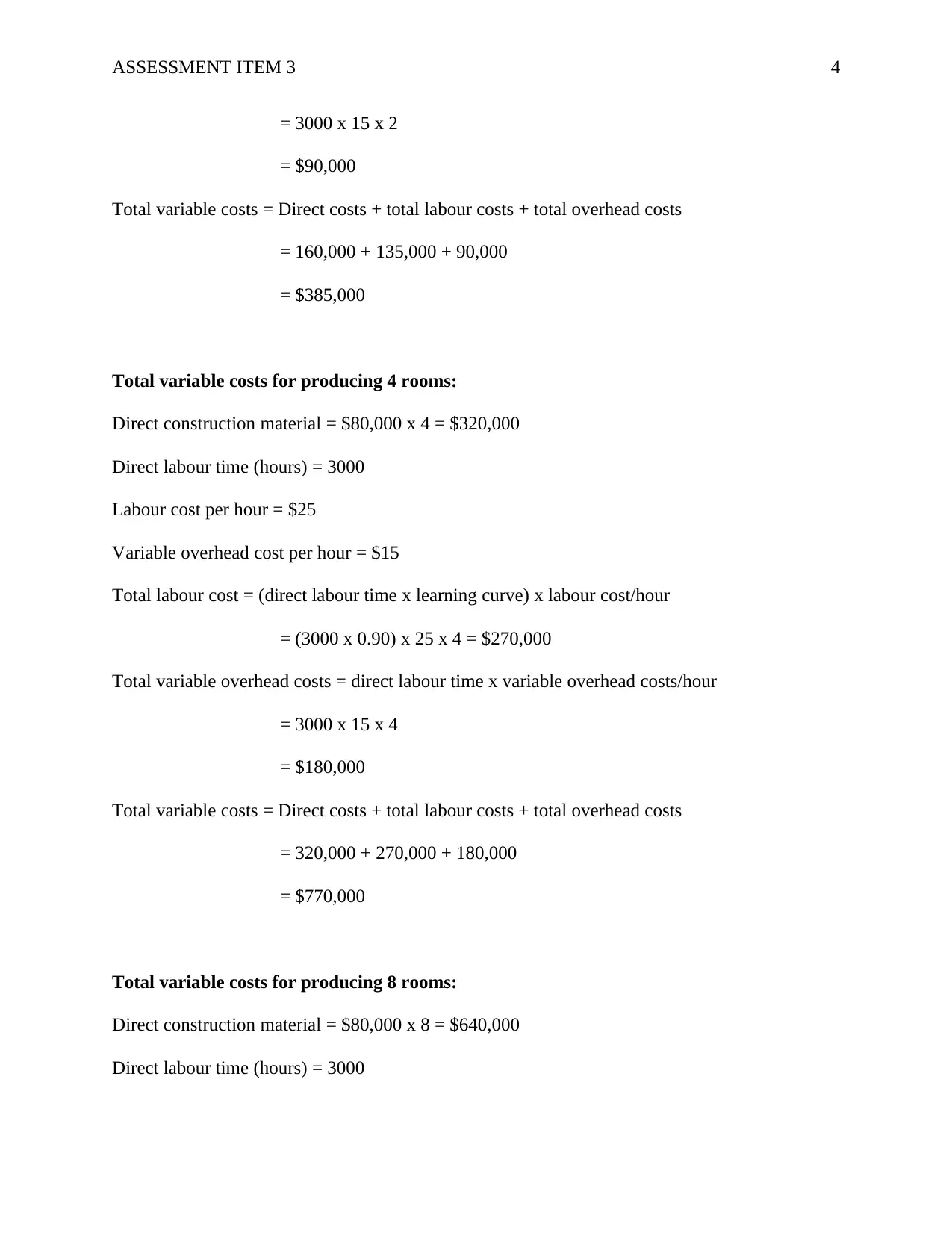
ASSESSMENT ITEM 3 4
= 3000 x 15 x 2
= $90,000
Total variable costs = Direct costs + total labour costs + total overhead costs
= 160,000 + 135,000 + 90,000
= $385,000
Total variable costs for producing 4 rooms:
Direct construction material = $80,000 x 4 = $320,000
Direct labour time (hours) = 3000
Labour cost per hour = $25
Variable overhead cost per hour = $15
Total labour cost = (direct labour time x learning curve) x labour cost/hour
= (3000 x 0.90) x 25 x 4 = $270,000
Total variable overhead costs = direct labour time x variable overhead costs/hour
= 3000 x 15 x 4
= $180,000
Total variable costs = Direct costs + total labour costs + total overhead costs
= 320,000 + 270,000 + 180,000
= $770,000
Total variable costs for producing 8 rooms:
Direct construction material = $80,000 x 8 = $640,000
Direct labour time (hours) = 3000
= 3000 x 15 x 2
= $90,000
Total variable costs = Direct costs + total labour costs + total overhead costs
= 160,000 + 135,000 + 90,000
= $385,000
Total variable costs for producing 4 rooms:
Direct construction material = $80,000 x 4 = $320,000
Direct labour time (hours) = 3000
Labour cost per hour = $25
Variable overhead cost per hour = $15
Total labour cost = (direct labour time x learning curve) x labour cost/hour
= (3000 x 0.90) x 25 x 4 = $270,000
Total variable overhead costs = direct labour time x variable overhead costs/hour
= 3000 x 15 x 4
= $180,000
Total variable costs = Direct costs + total labour costs + total overhead costs
= 320,000 + 270,000 + 180,000
= $770,000
Total variable costs for producing 8 rooms:
Direct construction material = $80,000 x 8 = $640,000
Direct labour time (hours) = 3000
Paraphrase This Document
Need a fresh take? Get an instant paraphrase of this document with our AI Paraphraser
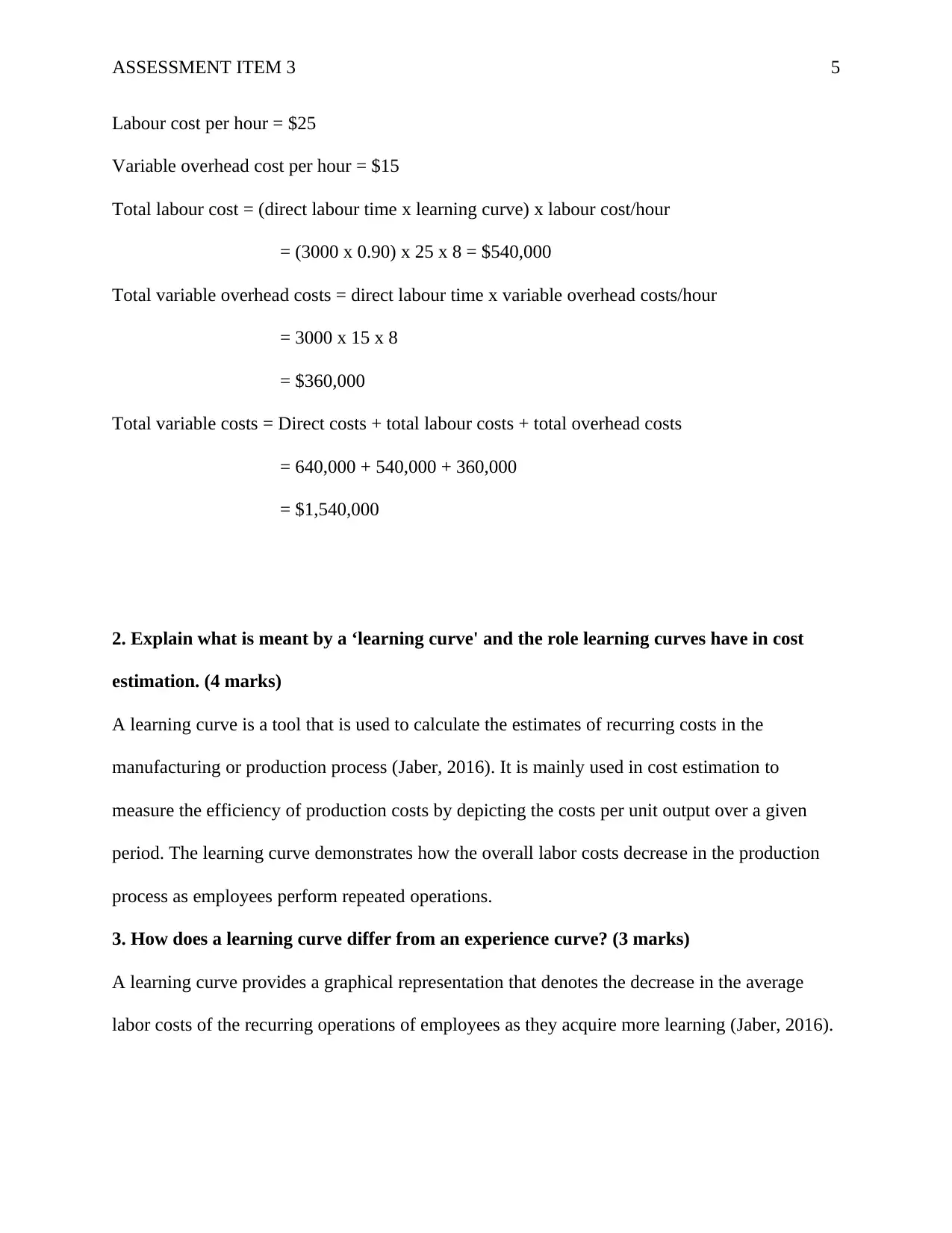
ASSESSMENT ITEM 3 5
Labour cost per hour = $25
Variable overhead cost per hour = $15
Total labour cost = (direct labour time x learning curve) x labour cost/hour
= (3000 x 0.90) x 25 x 8 = $540,000
Total variable overhead costs = direct labour time x variable overhead costs/hour
= 3000 x 15 x 8
= $360,000
Total variable costs = Direct costs + total labour costs + total overhead costs
= 640,000 + 540,000 + 360,000
= $1,540,000
2. Explain what is meant by a ‘learning curve' and the role learning curves have in cost
estimation. (4 marks)
A learning curve is a tool that is used to calculate the estimates of recurring costs in the
manufacturing or production process (Jaber, 2016). It is mainly used in cost estimation to
measure the efficiency of production costs by depicting the costs per unit output over a given
period. The learning curve demonstrates how the overall labor costs decrease in the production
process as employees perform repeated operations.
3. How does a learning curve differ from an experience curve? (3 marks)
A learning curve provides a graphical representation that denotes the decrease in the average
labor costs of the recurring operations of employees as they acquire more learning (Jaber, 2016).
Labour cost per hour = $25
Variable overhead cost per hour = $15
Total labour cost = (direct labour time x learning curve) x labour cost/hour
= (3000 x 0.90) x 25 x 8 = $540,000
Total variable overhead costs = direct labour time x variable overhead costs/hour
= 3000 x 15 x 8
= $360,000
Total variable costs = Direct costs + total labour costs + total overhead costs
= 640,000 + 540,000 + 360,000
= $1,540,000
2. Explain what is meant by a ‘learning curve' and the role learning curves have in cost
estimation. (4 marks)
A learning curve is a tool that is used to calculate the estimates of recurring costs in the
manufacturing or production process (Jaber, 2016). It is mainly used in cost estimation to
measure the efficiency of production costs by depicting the costs per unit output over a given
period. The learning curve demonstrates how the overall labor costs decrease in the production
process as employees perform repeated operations.
3. How does a learning curve differ from an experience curve? (3 marks)
A learning curve provides a graphical representation that denotes the decrease in the average
labor costs of the recurring operations of employees as they acquire more learning (Jaber, 2016).
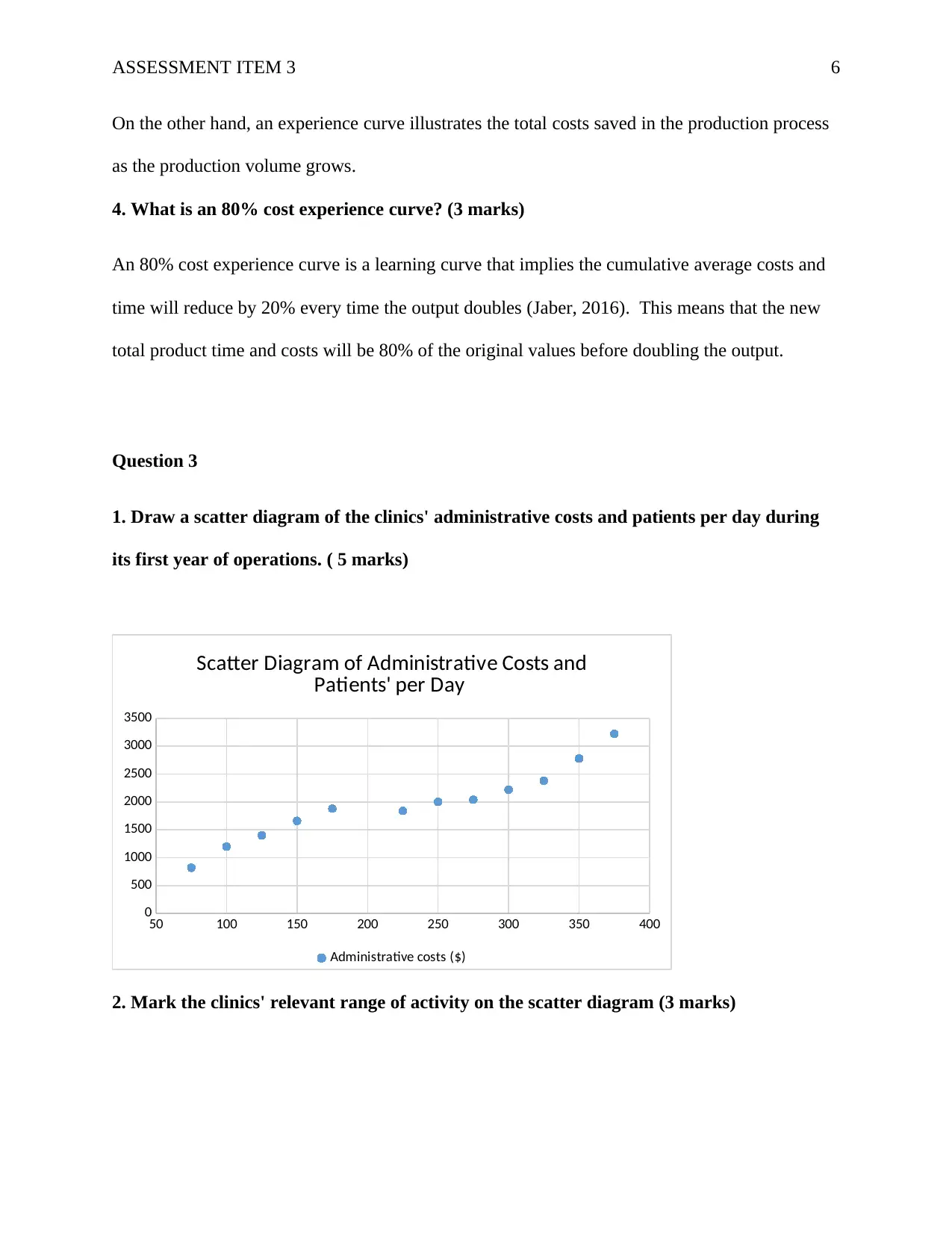
ASSESSMENT ITEM 3 6
On the other hand, an experience curve illustrates the total costs saved in the production process
as the production volume grows.
4. What is an 80% cost experience curve? (3 marks)
An 80% cost experience curve is a learning curve that implies the cumulative average costs and
time will reduce by 20% every time the output doubles (Jaber, 2016). This means that the new
total product time and costs will be 80% of the original values before doubling the output.
Question 3
1. Draw a scatter diagram of the clinics' administrative costs and patients per day during
its first year of operations. ( 5 marks)
50 100 150 200 250 300 350 400
0
500
1000
1500
2000
2500
3000
3500
Scatter Diagram of Administrative Costs and
Patients' per Day
Administrative costs ($)
2. Mark the clinics' relevant range of activity on the scatter diagram (3 marks)
On the other hand, an experience curve illustrates the total costs saved in the production process
as the production volume grows.
4. What is an 80% cost experience curve? (3 marks)
An 80% cost experience curve is a learning curve that implies the cumulative average costs and
time will reduce by 20% every time the output doubles (Jaber, 2016). This means that the new
total product time and costs will be 80% of the original values before doubling the output.
Question 3
1. Draw a scatter diagram of the clinics' administrative costs and patients per day during
its first year of operations. ( 5 marks)
50 100 150 200 250 300 350 400
0
500
1000
1500
2000
2500
3000
3500
Scatter Diagram of Administrative Costs and
Patients' per Day
Administrative costs ($)
2. Mark the clinics' relevant range of activity on the scatter diagram (3 marks)
⊘ This is a preview!⊘
Do you want full access?
Subscribe today to unlock all pages.

Trusted by 1+ million students worldwide
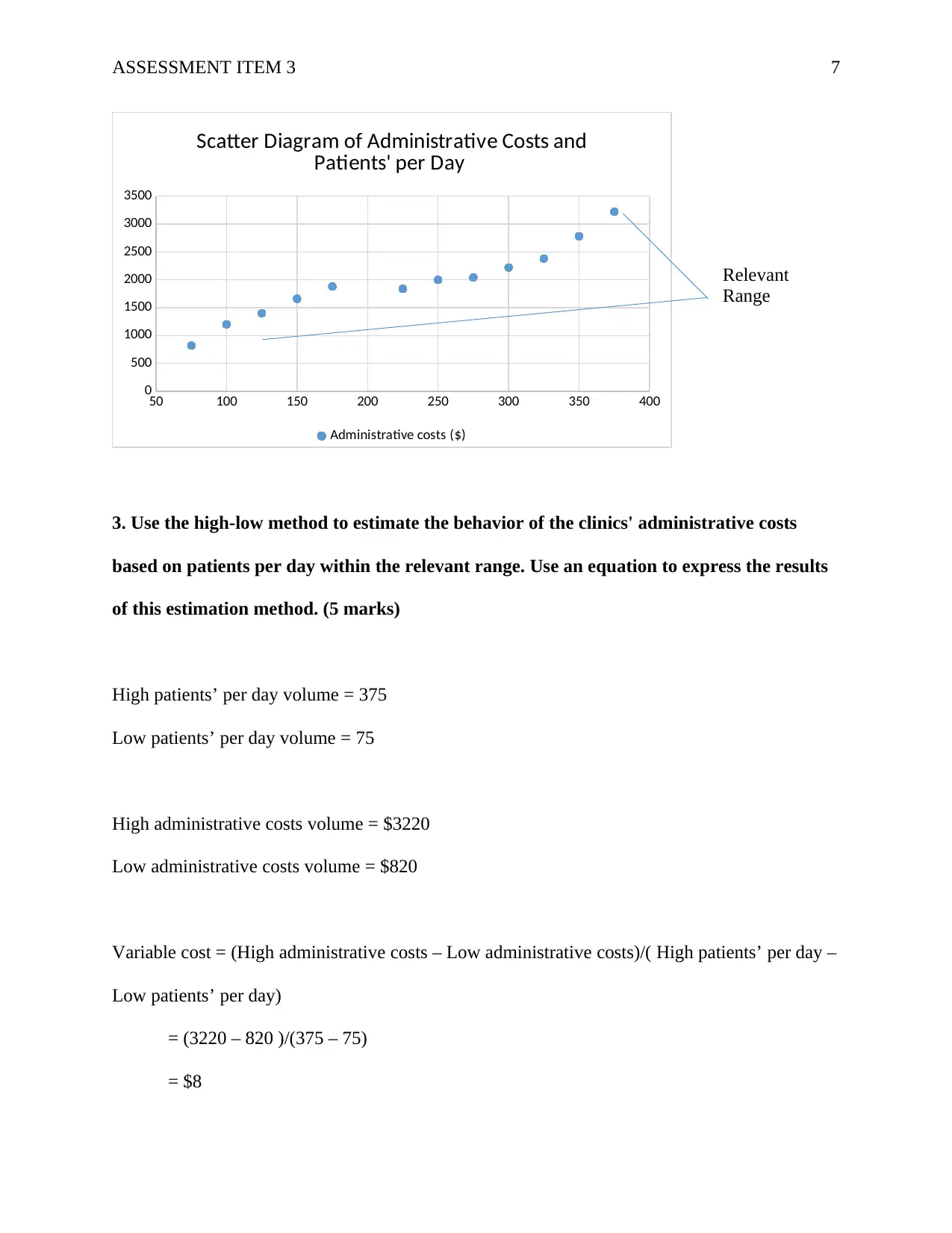
ASSESSMENT ITEM 3 7
50 100 150 200 250 300 350 400
0
500
1000
1500
2000
2500
3000
3500
Scatter Diagram of Administrative Costs and
Patients' per Day
Administrative costs ($)
3. Use the high-low method to estimate the behavior of the clinics' administrative costs
based on patients per day within the relevant range. Use an equation to express the results
of this estimation method. (5 marks)
High patients’ per day volume = 375
Low patients’ per day volume = 75
High administrative costs volume = $3220
Low administrative costs volume = $820
Variable cost = (High administrative costs – Low administrative costs)/( High patients’ per day –
Low patients’ per day)
= (3220 – 820 )/(375 – 75)
= $8
Relevant
Range
50 100 150 200 250 300 350 400
0
500
1000
1500
2000
2500
3000
3500
Scatter Diagram of Administrative Costs and
Patients' per Day
Administrative costs ($)
3. Use the high-low method to estimate the behavior of the clinics' administrative costs
based on patients per day within the relevant range. Use an equation to express the results
of this estimation method. (5 marks)
High patients’ per day volume = 375
Low patients’ per day volume = 75
High administrative costs volume = $3220
Low administrative costs volume = $820
Variable cost = (High administrative costs – Low administrative costs)/( High patients’ per day –
Low patients’ per day)
= (3220 – 820 )/(375 – 75)
= $8
Relevant
Range
Paraphrase This Document
Need a fresh take? Get an instant paraphrase of this document with our AI Paraphraser
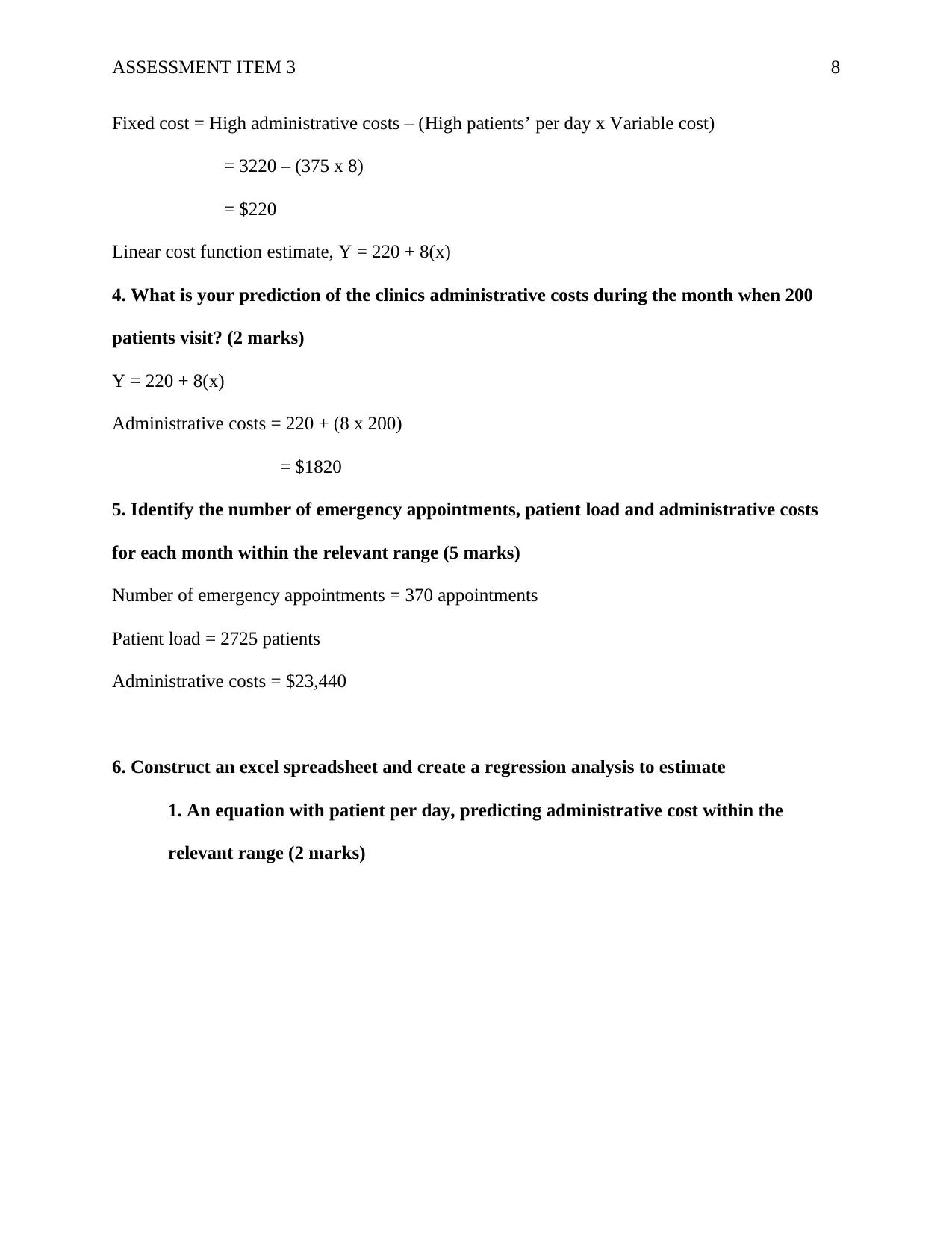
ASSESSMENT ITEM 3 8
Fixed cost = High administrative costs – (High patients’ per day x Variable cost)
= 3220 – (375 x 8)
= $220
Linear cost function estimate, Y = 220 + 8(x)
4. What is your prediction of the clinics administrative costs during the month when 200
patients visit? (2 marks)
Y = 220 + 8(x)
Administrative costs = 220 + (8 x 200)
= $1820
5. Identify the number of emergency appointments, patient load and administrative costs
for each month within the relevant range (5 marks)
Number of emergency appointments = 370 appointments
Patient load = 2725 patients
Administrative costs = $23,440
6. Construct an excel spreadsheet and create a regression analysis to estimate
1. An equation with patient per day, predicting administrative cost within the
relevant range (2 marks)
Fixed cost = High administrative costs – (High patients’ per day x Variable cost)
= 3220 – (375 x 8)
= $220
Linear cost function estimate, Y = 220 + 8(x)
4. What is your prediction of the clinics administrative costs during the month when 200
patients visit? (2 marks)
Y = 220 + 8(x)
Administrative costs = 220 + (8 x 200)
= $1820
5. Identify the number of emergency appointments, patient load and administrative costs
for each month within the relevant range (5 marks)
Number of emergency appointments = 370 appointments
Patient load = 2725 patients
Administrative costs = $23,440
6. Construct an excel spreadsheet and create a regression analysis to estimate
1. An equation with patient per day, predicting administrative cost within the
relevant range (2 marks)
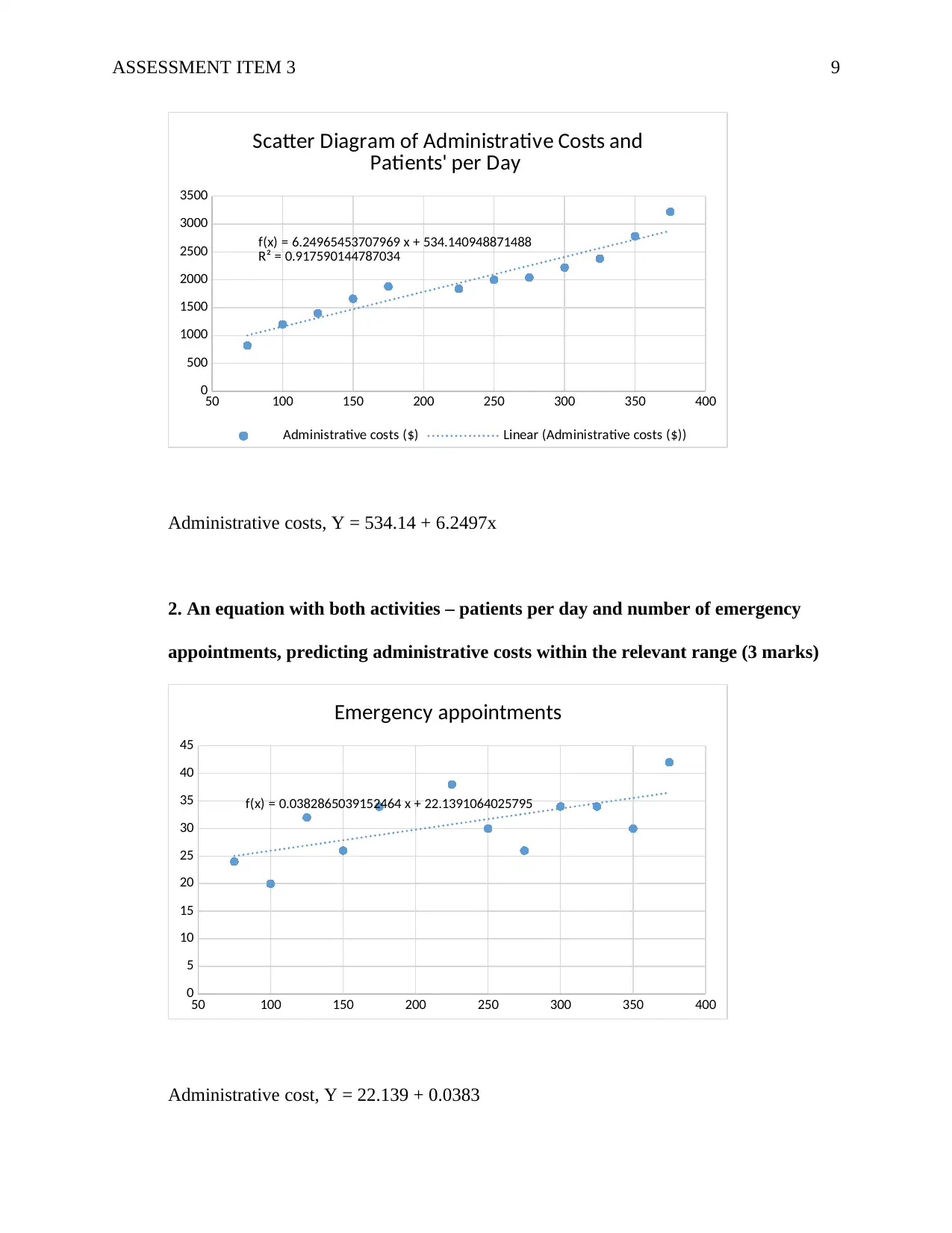
ASSESSMENT ITEM 3 9
50 100 150 200 250 300 350 400
0
500
1000
1500
2000
2500
3000
3500
f(x) = 6.24965453707969 x + 534.140948871488
R² = 0.917590144787034
Scatter Diagram of Administrative Costs and
Patients' per Day
Administrative costs ($) Linear (Administrative costs ($))
Administrative costs, Y = 534.14 + 6.2497x
2. An equation with both activities – patients per day and number of emergency
appointments, predicting administrative costs within the relevant range (3 marks)
50 100 150 200 250 300 350 400
0
5
10
15
20
25
30
35
40
45
f(x) = 0.0382865039152464 x + 22.1391064025795
Emergency appointments
Administrative cost, Y = 22.139 + 0.0383
50 100 150 200 250 300 350 400
0
500
1000
1500
2000
2500
3000
3500
f(x) = 6.24965453707969 x + 534.140948871488
R² = 0.917590144787034
Scatter Diagram of Administrative Costs and
Patients' per Day
Administrative costs ($) Linear (Administrative costs ($))
Administrative costs, Y = 534.14 + 6.2497x
2. An equation with both activities – patients per day and number of emergency
appointments, predicting administrative costs within the relevant range (3 marks)
50 100 150 200 250 300 350 400
0
5
10
15
20
25
30
35
40
45
f(x) = 0.0382865039152464 x + 22.1391064025795
Emergency appointments
Administrative cost, Y = 22.139 + 0.0383
⊘ This is a preview!⊘
Do you want full access?
Subscribe today to unlock all pages.

Trusted by 1+ million students worldwide
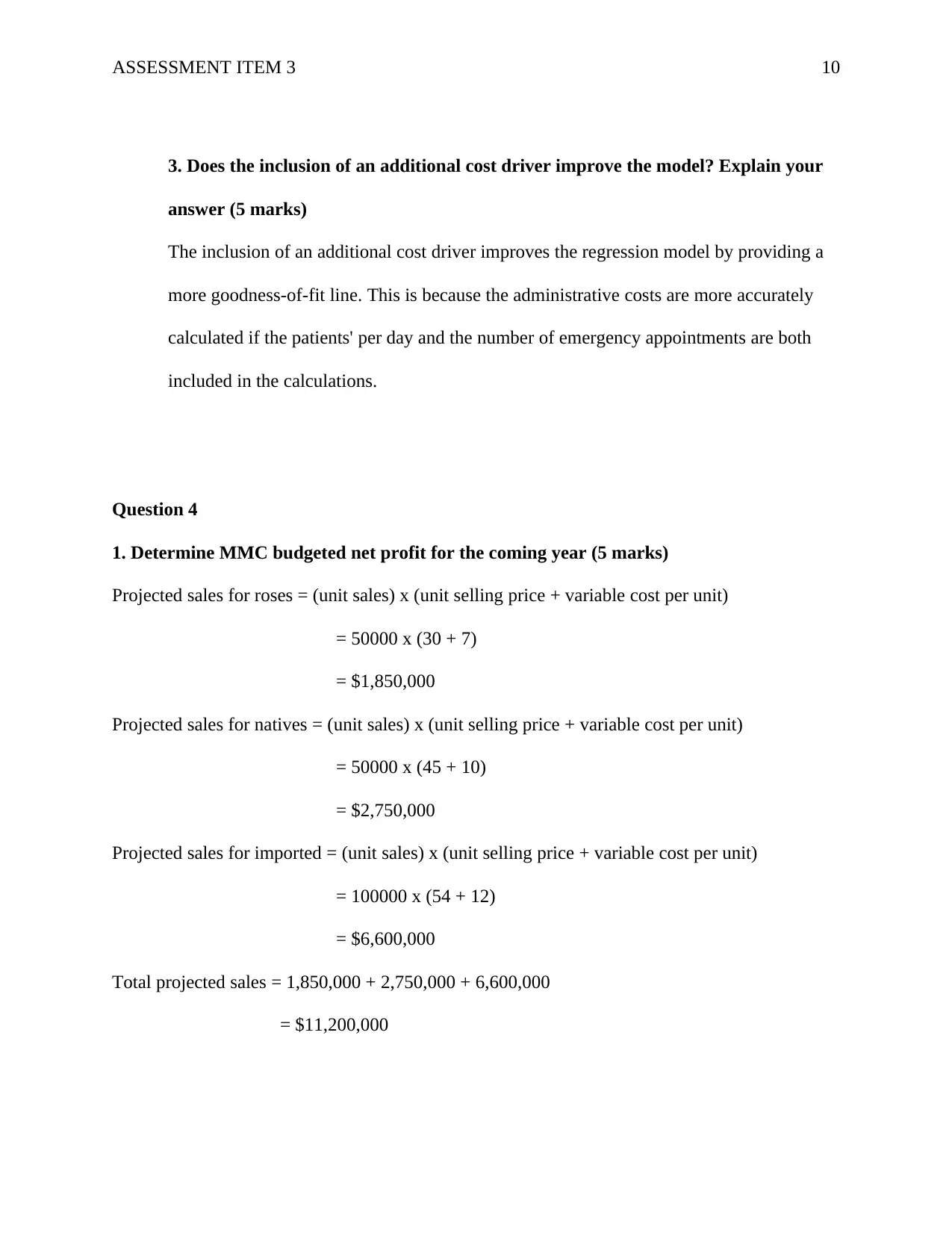
ASSESSMENT ITEM 3 10
3. Does the inclusion of an additional cost driver improve the model? Explain your
answer (5 marks)
The inclusion of an additional cost driver improves the regression model by providing a
more goodness-of-fit line. This is because the administrative costs are more accurately
calculated if the patients' per day and the number of emergency appointments are both
included in the calculations.
Question 4
1. Determine MMC budgeted net profit for the coming year (5 marks)
Projected sales for roses = (unit sales) x (unit selling price + variable cost per unit)
= 50000 x (30 + 7)
= $1,850,000
Projected sales for natives = (unit sales) x (unit selling price + variable cost per unit)
= 50000 x (45 + 10)
= $2,750,000
Projected sales for imported = (unit sales) x (unit selling price + variable cost per unit)
= 100000 x (54 + 12)
= $6,600,000
Total projected sales = 1,850,000 + 2,750,000 + 6,600,000
= $11,200,000
3. Does the inclusion of an additional cost driver improve the model? Explain your
answer (5 marks)
The inclusion of an additional cost driver improves the regression model by providing a
more goodness-of-fit line. This is because the administrative costs are more accurately
calculated if the patients' per day and the number of emergency appointments are both
included in the calculations.
Question 4
1. Determine MMC budgeted net profit for the coming year (5 marks)
Projected sales for roses = (unit sales) x (unit selling price + variable cost per unit)
= 50000 x (30 + 7)
= $1,850,000
Projected sales for natives = (unit sales) x (unit selling price + variable cost per unit)
= 50000 x (45 + 10)
= $2,750,000
Projected sales for imported = (unit sales) x (unit selling price + variable cost per unit)
= 100000 x (54 + 12)
= $6,600,000
Total projected sales = 1,850,000 + 2,750,000 + 6,600,000
= $11,200,000
Paraphrase This Document
Need a fresh take? Get an instant paraphrase of this document with our AI Paraphraser
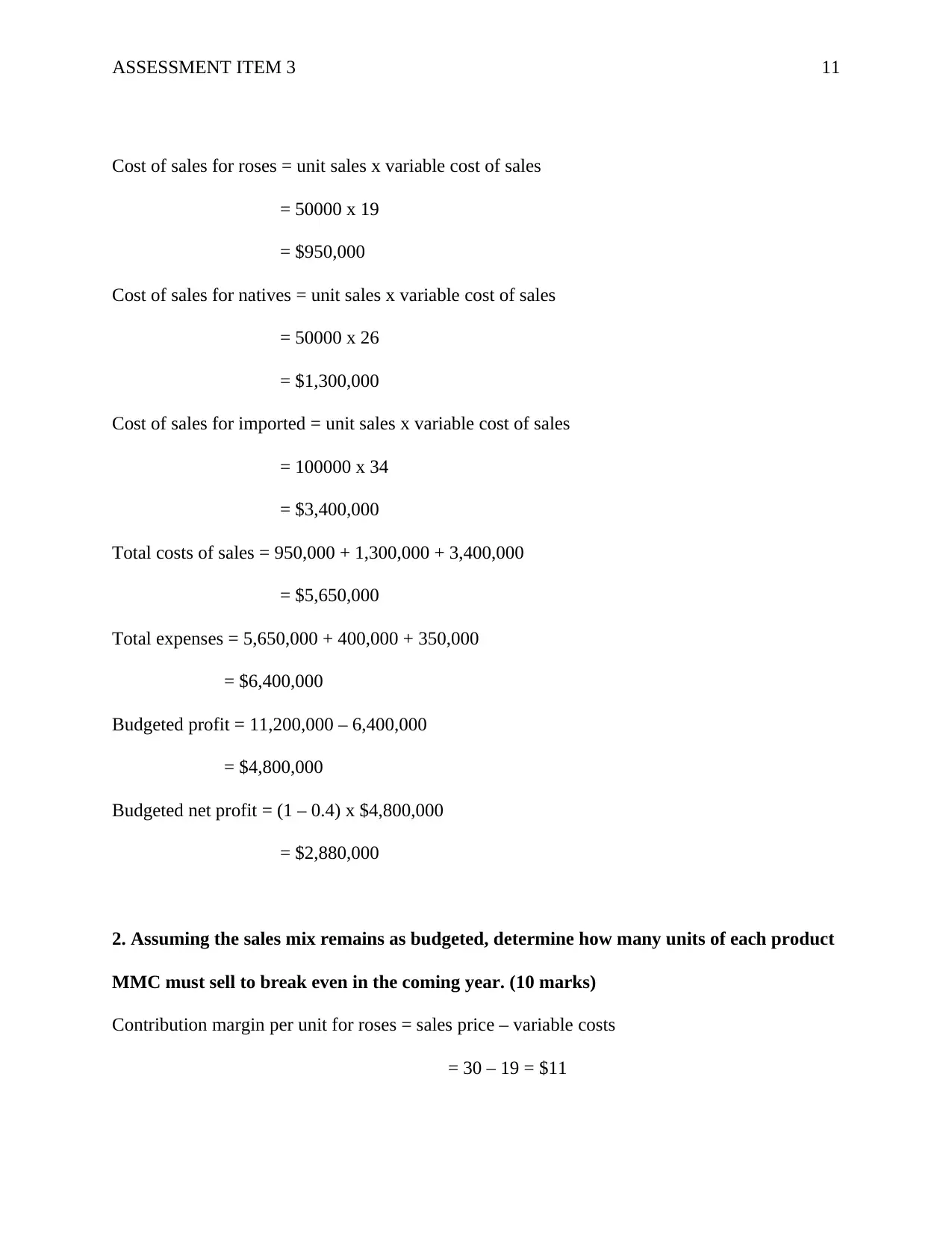
ASSESSMENT ITEM 3 11
Cost of sales for roses = unit sales x variable cost of sales
= 50000 x 19
= $950,000
Cost of sales for natives = unit sales x variable cost of sales
= 50000 x 26
= $1,300,000
Cost of sales for imported = unit sales x variable cost of sales
= 100000 x 34
= $3,400,000
Total costs of sales = 950,000 + 1,300,000 + 3,400,000
= $5,650,000
Total expenses = 5,650,000 + 400,000 + 350,000
= $6,400,000
Budgeted profit = 11,200,000 – 6,400,000
= $4,800,000
Budgeted net profit = (1 – 0.4) x $4,800,000
= $2,880,000
2. Assuming the sales mix remains as budgeted, determine how many units of each product
MMC must sell to break even in the coming year. (10 marks)
Contribution margin per unit for roses = sales price – variable costs
= 30 – 19 = $11
Cost of sales for roses = unit sales x variable cost of sales
= 50000 x 19
= $950,000
Cost of sales for natives = unit sales x variable cost of sales
= 50000 x 26
= $1,300,000
Cost of sales for imported = unit sales x variable cost of sales
= 100000 x 34
= $3,400,000
Total costs of sales = 950,000 + 1,300,000 + 3,400,000
= $5,650,000
Total expenses = 5,650,000 + 400,000 + 350,000
= $6,400,000
Budgeted profit = 11,200,000 – 6,400,000
= $4,800,000
Budgeted net profit = (1 – 0.4) x $4,800,000
= $2,880,000
2. Assuming the sales mix remains as budgeted, determine how many units of each product
MMC must sell to break even in the coming year. (10 marks)
Contribution margin per unit for roses = sales price – variable costs
= 30 – 19 = $11
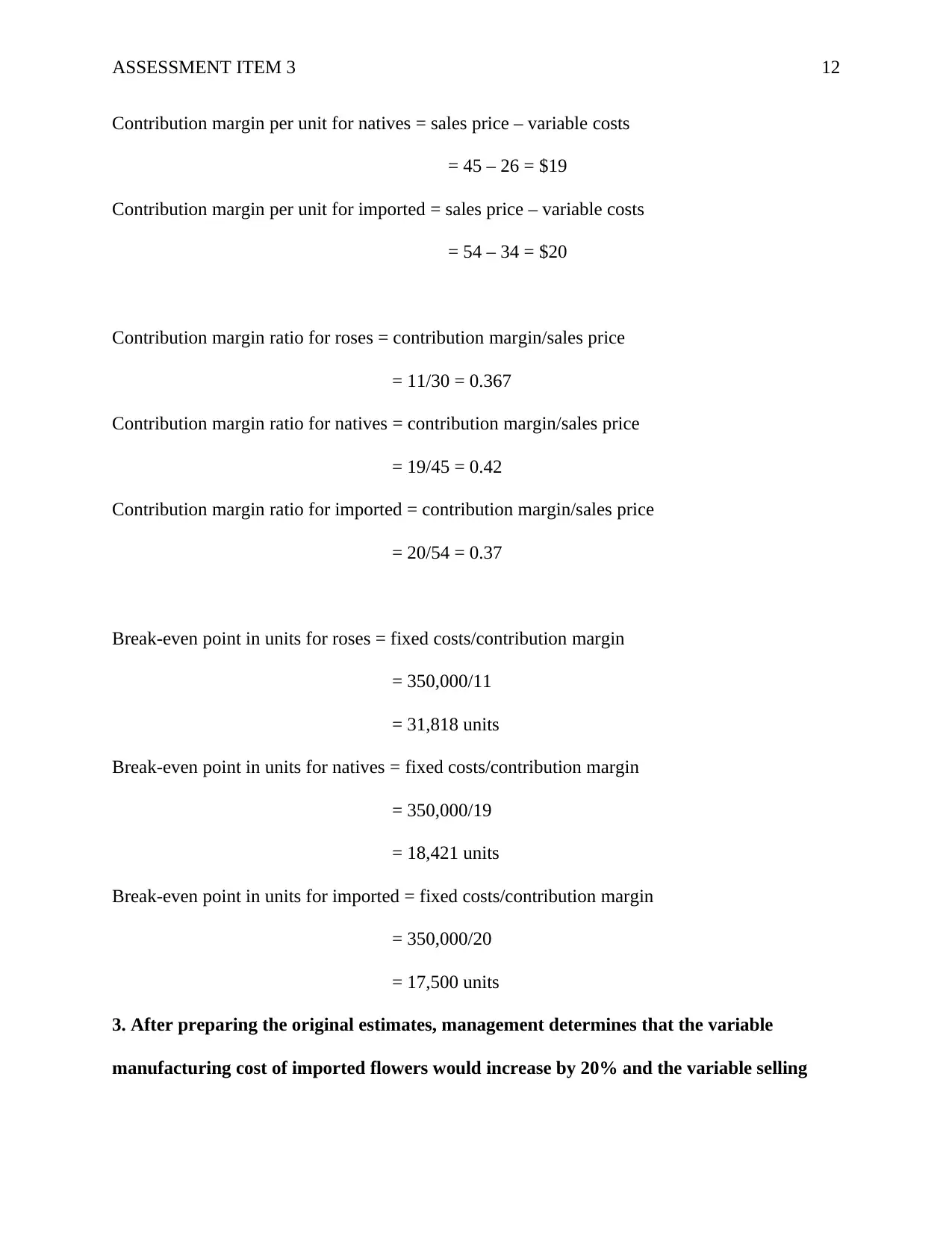
ASSESSMENT ITEM 3 12
Contribution margin per unit for natives = sales price – variable costs
= 45 – 26 = $19
Contribution margin per unit for imported = sales price – variable costs
= 54 – 34 = $20
Contribution margin ratio for roses = contribution margin/sales price
= 11/30 = 0.367
Contribution margin ratio for natives = contribution margin/sales price
= 19/45 = 0.42
Contribution margin ratio for imported = contribution margin/sales price
= 20/54 = 0.37
Break-even point in units for roses = fixed costs/contribution margin
= 350,000/11
= 31,818 units
Break-even point in units for natives = fixed costs/contribution margin
= 350,000/19
= 18,421 units
Break-even point in units for imported = fixed costs/contribution margin
= 350,000/20
= 17,500 units
3. After preparing the original estimates, management determines that the variable
manufacturing cost of imported flowers would increase by 20% and the variable selling
Contribution margin per unit for natives = sales price – variable costs
= 45 – 26 = $19
Contribution margin per unit for imported = sales price – variable costs
= 54 – 34 = $20
Contribution margin ratio for roses = contribution margin/sales price
= 11/30 = 0.367
Contribution margin ratio for natives = contribution margin/sales price
= 19/45 = 0.42
Contribution margin ratio for imported = contribution margin/sales price
= 20/54 = 0.37
Break-even point in units for roses = fixed costs/contribution margin
= 350,000/11
= 31,818 units
Break-even point in units for natives = fixed costs/contribution margin
= 350,000/19
= 18,421 units
Break-even point in units for imported = fixed costs/contribution margin
= 350,000/20
= 17,500 units
3. After preparing the original estimates, management determines that the variable
manufacturing cost of imported flowers would increase by 20% and the variable selling
⊘ This is a preview!⊘
Do you want full access?
Subscribe today to unlock all pages.

Trusted by 1+ million students worldwide
1 out of 16
Related Documents
Your All-in-One AI-Powered Toolkit for Academic Success.
+13062052269
info@desklib.com
Available 24*7 on WhatsApp / Email
![[object Object]](/_next/static/media/star-bottom.7253800d.svg)
Unlock your academic potential
Copyright © 2020–2025 A2Z Services. All Rights Reserved. Developed and managed by ZUCOL.




